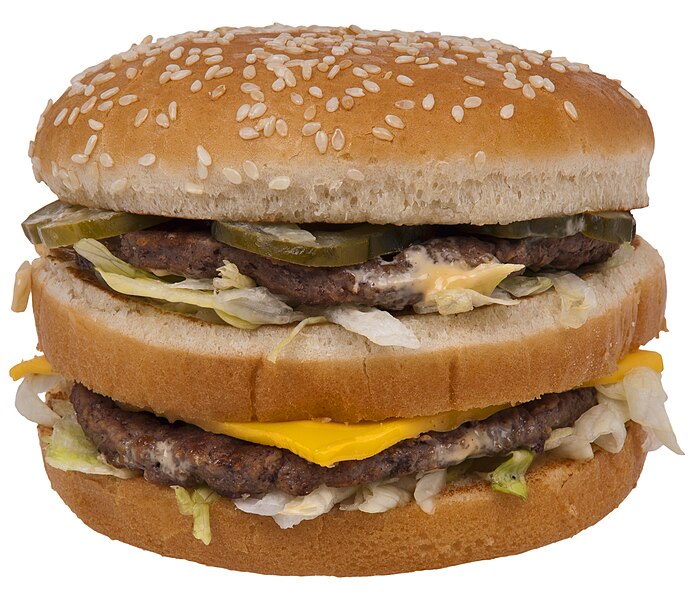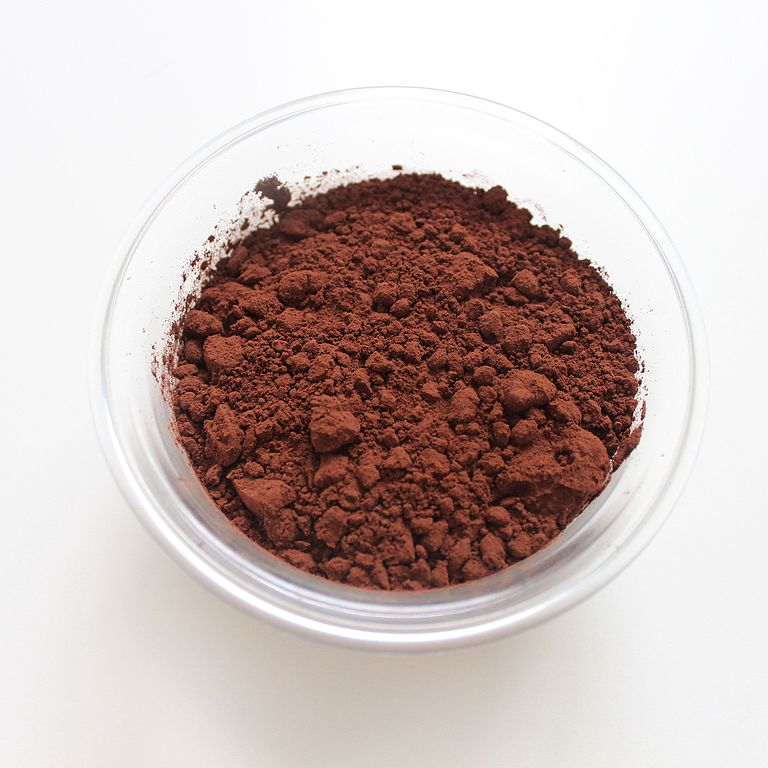Big Mac vs. Cocoa Powder
Nutrition comparison of Big Mac and Cocoa Powder
Ever wonder how your favorite foods stack up against each other in terms of nutrition?
We compared the nutritional contents of
big mac
versus
cocoa powder
(100g each)
below using 2020 USDA and NIH data[1].
For a quick recap of significant nutrients and differences in big mac and cocoa powder:
- Both cocoa powder and big mac are high in calcium, calories and protein.
- Big mac has more thiamin and Vitamin B12, however, cocoa powder contains more pantothenic acid and Vitamin B6.
- Cocoa powder is an excellent source of dietary fiber, iron and potassium.
USDA sources for nutritional information: Big Mac (McDONALD'S, BIG MAC) and Cocoa Powder (Cocoa, dry powder, unsweetened) . Have a correction or suggestions? Shoot us an email.
Calories and Carbs
calories
Both cocoa powder and big mac are high in calories. Big mac has 13% more calories than cocoa powder - cocoa powder has 228 calories per 100 grams and big mac has 257 calories.
For macronutrient ratios, big mac is much lighter in carbs, much heavier in fat and similar to cocoa powder for protein. Big mac has a macronutrient ratio of 18:31:51 and for cocoa powder, 19:54:27 for protein, carbohydrates and fat from calories.
Macro Ratios from Calories:
| Big Mac | Cocoa Powder | |
|---|---|---|
| Protein | 18% | 19% |
| Carbohydrates | 31% | 54% |
| Fat | 51% | 27% |
| Alcohol | ~ | ~ |
carbohydrates
Cocoa powder is high in carbohydrates and big mac has 65% less carbohydrates than cocoa powder - cocoa powder has 57.9g of total carbs per 100 grams and big mac has 20.1g of carbohydrates.
dietary fiber
Cocoa powder is an excellent source of dietary fiber and it has 22 times more dietary fiber than big mac - cocoa powder has 37g of dietary fiber per 100 grams and big mac has 1.6g of dietary fiber.
sugar
Cocoa powder and big mac contain similar amounts of sugar - cocoa powder has 1.8g of sugar per 100 grams and big mac has 4g of sugar.
Protein
protein
Both cocoa powder and big mac are high in protein. Cocoa powder has 66% more protein than big mac - cocoa powder has 19.6g of protein per 100 grams and big mac has 11.8g of protein.
Fat
saturated fat
Cocoa powder is high in saturated fat and big mac has 53% less saturated fat than cocoa powder - cocoa powder has 8.1g of saturated fat per 100 grams and big mac has 3.8g of saturated fat.
cholesterol
Cocoa powder has less cholesterol than big mac - big mac has 36mg of cholesterol per 100 grams and cocoa powder does not contain significant amounts.
Vitamins
Vitamin C
Big mac and cocoa powder contain similar amounts of Vitamin C - big mac has 0.4mg of Vitamin C per 100 grams and cocoa powder does not contain significant amounts.
Vitamin A
Big mac has more Vitamin A than cocoa powder - big mac has 56.5ug of Vitamin A per 100 grams and cocoa powder does not contain significant amounts.
Vitamin E
Cocoa powder and big mac contain similar amounts of Vitamin E - cocoa powder has 0.1mg of Vitamin E per 100 grams and big mac does not contain significant amounts.
Vitamin K
Cocoa powder and big mac contain similar amounts of Vitamin K - cocoa powder has 2.5ug of Vitamin K per 100 grams and big mac does not contain significant amounts.
The B Vitamins
Big mac has more thiamin and Vitamin B12, however, cocoa powder contains more pantothenic acid and Vitamin B6. Both big mac and cocoa powder contain significant amounts of riboflavin, niacin and folate.
| Big Mac | Cocoa Powder | |
|---|---|---|
| Thiamin | 0.176 MG | 0.078 MG |
| Riboflavin | 0.209 MG | 0.241 MG |
| Niacin | 3.384 MG | 2.185 MG |
| Pantothenic acid | ~ | 0.254 MG |
| Vitamin B6 | ~ | 0.118 MG |
| Folate | 46 UG | 32 UG |
| Vitamin B12 | 0.88 UG | ~ |
Minerals
calcium
Both cocoa powder and big mac are high in calcium. Cocoa powder has a little more calcium (10%) than big mac by weight - cocoa powder has 128mg of calcium per 100 grams and big mac has 116mg of calcium.
iron
Cocoa powder is an excellent source of iron and it has 593% more iron than big mac - cocoa powder has 13.9mg of iron per 100 grams and big mac has 2mg of iron.
potassium
Cocoa powder is an excellent source of potassium and it has 742% more potassium than big mac - cocoa powder has 1524mg of potassium per 100 grams and big mac has 181mg of potassium.
Customize your serving size
The comparison below is by common portions, e.g. cups, packages. You can also see a more concrete comparison by weight at equal weight (by grams) comparison.
Note: The specific food items compared are: Big Mac (McDONALD'S, BIG MAC) and Cocoa Powder (Cocoa, dry powder, unsweetened) .
Big Mac g
()
|
Daily Values (%) |
Cocoa Powder g
()
|
|||||
|---|---|---|---|---|---|---|---|
| KCAL % |
|
5% | calories | 5% |
|
KCAL % | |
| G % |
|
5% | carbohydrates | 5% |
|
G % | |
| G % |
|
5% | dietary fiber | 5% |
|
G % | |
| G | 5% | sugar | 5% | G | |||
| G % |
|
5% | total fat | 5% |
|
G % | |
| G % |
|
5% | saturated fat | 5% |
|
G % | |
| G | 5% | monounsaturated fat | 5% | G | |||
| G | 5% | polyunsaturated fat | 5% | G | |||
| G | 5% | trans fat | 5% | G | |||
| MG | 5% | cholesterol | 5% | MG | |||
| MG % |
|
5% | sodium | 5% |
|
MG % | |
| 5% | Vitamins and Minerals | 5% | |||||
| UG % |
|
5% | Vitamin A | 5% |
|
UG % | |
| MG % |
|
5% | Vitamin C | 5% |
|
MG % | |
| IU % |
|
5% | Vitamin D | 5% |
|
IU % | |
| MG % |
|
5% | calcium | 5% |
|
MG % | |
| MG % |
|
5% | iron | 5% |
|
MG % | |
| MG % |
|
5% | magnesium | 5% |
|
MG % | |
| MG % |
|
5% | potassium | 5% |
|
MG % | |
| MG % |
|
5% | thiamin (Vit B1) | 5% |
|
MG % | |
| MG % |
|
5% | riboflavin (Vit B2) | 5% |
|
MG % | |
| MG % |
|
5% | niacin (Vit B3) | 5% |
|
MG % | |
| MG % |
|
5% | Vitamin B6 | 5% |
|
MG % | |
| MG % |
|
5% | pantothenic acid (Vit B5) | 5% |
|
MG % | |
| UG % |
|
5% | folate (Vit B9) | 5% |
|
UG % | |
| UG % |
|
5% | Vitamin B12 | 5% |
|
UG % | |
| MG % |
|
5% | Vitamin E | 5% |
|
MG % | |
| UG % |
|
5% | Vitamin K | 5% |
|
UG % | |
| G % |
|
5% | protein | 5% |
|
G % | |
| UG % |
|
5% | biotin (Vit B7) | 5% |
|
UG % | |
| MG % |
|
5% | choline | 5% |
|
MG % | |
| MG % |
|
5% | chlorine | 5% |
|
MG % | |
| UG % |
|
5% | chromium | 5% |
|
UG % | |
| MG % |
|
5% | copper | 5% |
|
MG % | |
| UG % |
|
5% | fluoride | 5% |
|
UG % | |
| UG % |
|
5% | iodine | 5% |
|
UG % | |
| MG % |
|
5% | manganese | 5% |
|
MG % | |
| UG % |
|
5% | molybdenum | 5% |
|
UG % | |
| MG % |
|
5% | phosphorus | 5% |
|
MG % | |
| UG % |
|
5% | selenium | 5% |
|
UG % | |
| MG % |
|
5% | zinc | 5% |
|
MG % | |
| G | 5% | Water | 5% | G | |||
| G | 5% | Starch | 5% | G | |||
| G | 5% | Alcohol | 5% | G | |||
FAQ
Does cocoa powder or big mac contain more calories in 100 grams?Both cocoa powder and big mac are high in calories. Big mac has 10% more calories than cocoa powder - cocoa powder has 228 calories in 100g and big mac has 257 calories.
Does cocoa powder or big mac have more carbohydrates?
By weight, cocoa powder is high in carbohydrates and big mac has 70% fewer carbohydrates than cocoa powder - cocoa powder has 57.9g of carbs for 100g and big mac has 20.1g of carbohydrates.
Does cocoa powder or big mac contain more calcium?
Both cocoa powder and big mac are high in calcium. Cocoa powder has a little more calcium ( 10%) than big mac by weight - cocoa powder has 128mg of calcium in 100 grams and big mac has 116mg of calcium.
Does cocoa powder or big mac contain more iron?
Cocoa powder is an abundant source of iron and it has 590% more iron than big mac - cocoa powder has 13.9mg of iron in 100 grams and big mac has 2mg of iron.
Does cocoa powder or big mac contain more potassium?
Cocoa powder is a rich source of potassium and it has 740% more potassium than big mac - cocoa powder has 1524mg of potassium in 100 grams and big mac has 181mg of potassium.

